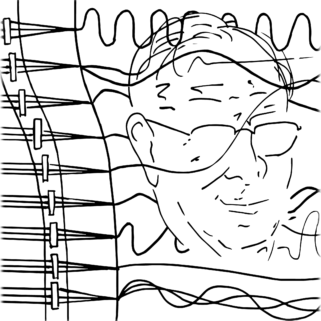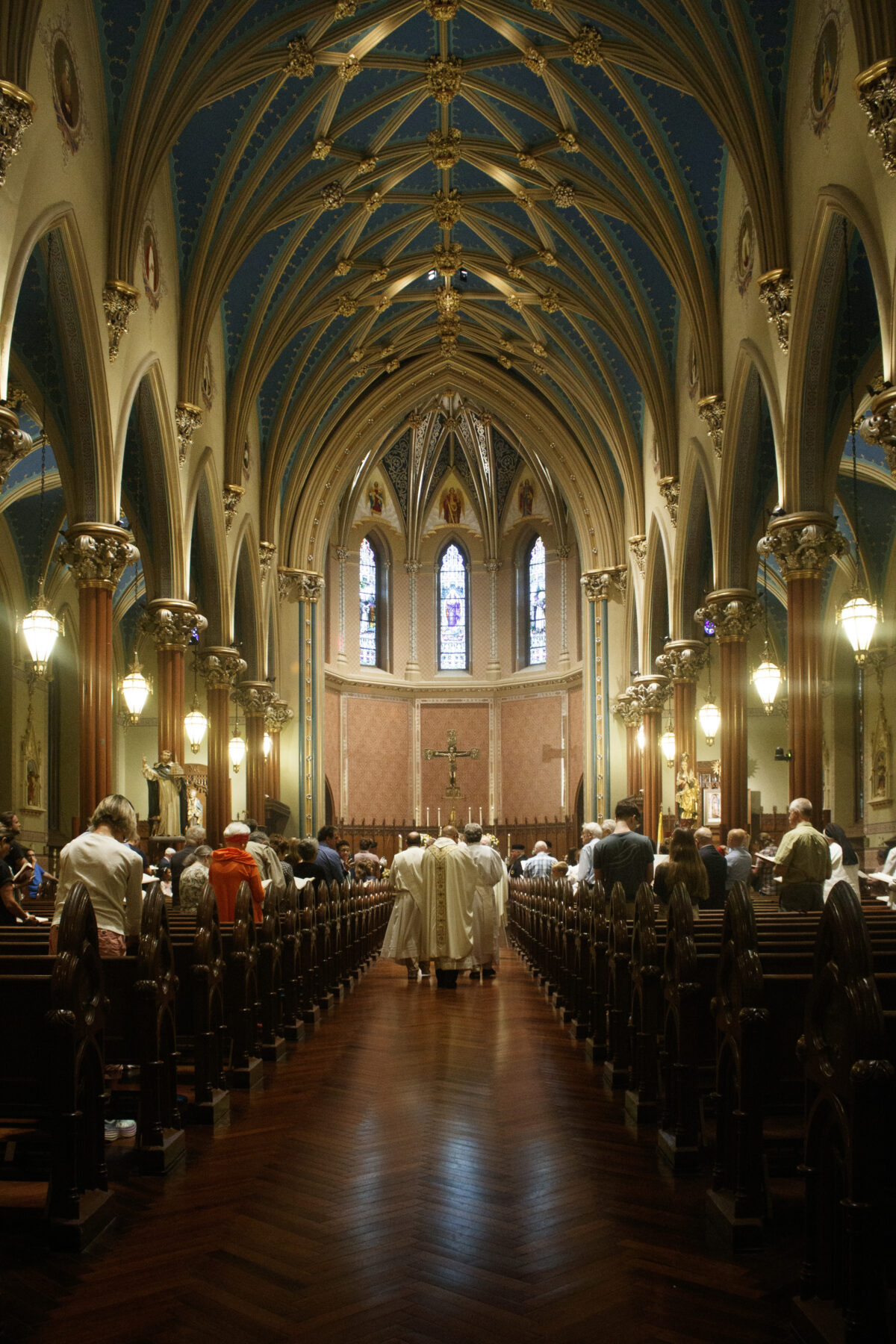
I. THE MIRACLE
Twenty weeks into her pregnancy, in February 2015, Michelle Schachle and her husband Daniel were told their baby would not survive. An ultrasound had revealed severe fluid buildup that risked harming Michelle, too. Doctors at the Vanderbilt University Medical Center recommended terminating the pregnancy. For the devoutly Catholic couple, abortion was off the table. The suggestion angered Dan. “It’s my job to protect my children, not to kill them,” he recalls thinking. The Schachles made worst-case plans to bury the baby in their yard, in rural Tennessee. And they began to pray.
They prayed for Father Michael McGivney, a nineteenth-century Connecticut priest, to press God to intervene on the fetus’s behalf. In 1882, McGivney founded the Knights of Columbus, a Catholic men’s organization that sells life insurance. Inspired by McGivney, Dan had found his calling as an insurance agent for the Knights, and his sales won him and Michelle spots on a 2015 reward trip to Europe. It came at an opportune time. The couple prayed for McGivney’s aid at the Vatican, and again at the Sanctuary of Fátima, a popular pilgrimage site in Portugal, where they heard a gospel reading in which Jesus tells a nobleman whose son is sick: “You may go; your son will live.”
Right after they returned from Europe, Michelle had another ultrasound. The swelling was gone. In only the 31st week of pregnancy, she had a C-section, giving birth to a son with Down syndrome. Fear and hope melted into gratefulness. Dan and Michelle named their thirteenth child Michael McGivney Schachle. Ever the company man, Dan called a top Knights executive he had met in Portugal to report the remarkable turnaround. According to Dan, the executive passed the news to a colleague at the New Haven headquarters with a simple message: “I think we might have your McGivney miracle in Tennessee.”
The Knights had already pushed their founder well on the path to sainthood, but the world’s biggest Roman Catholic fraternal group needed two divine miracles to close the deal. The story of the new Michael McGivney—since retold in numerous news articles, Catholic podcasts and Knights videos—would, five years and five months later, bring the former Michael McGivney one step away from sainthood. It would reshape the Knights’ publicity and the face of New Haven Catholic life. It would especially begin to transform St. Mary’s Church, where McGivney and a crew of laymen established the Knights, and where today his body rests entombed and his portrait hangs outside.
McGivney may, before long, become the first American-born man to be recognized by the Vatican as a canonized saint. To join the canon of saints, one must meet centuries-old standards of holiness that confirm one’s eternal place in heaven. Yet the process—driven by efforts and outcomes beyond the dead candidate’s control—draws in a vortex of characters, events and ideas that make up their own canon, a sort of afterlife on Earth. At the end of a saga playing out across the places and cyberspaces of twenty-first century America, New Haven may emerge as a focal point of Catholicism in the country, and McGivney as a preeminent mold for American Catholic manhood.
On May 15, 2015, the day Michael Schachle was born, the campaign for a Saint McGivney received a new breath of life.
II. MUTUAL AID
Mikey Schachle (pronounced “shackle”) cleared a path through his relatives to jump on the trampoline with his brother and little niece. He repeatedly uttered “buh-ba-beach,” which his brother decoded as “Backyard Beach,” a song from “Phineas and Ferb.” When rain began to pelt down, Mikey, gripping a mini croissant in his right hand, proclaimed, “A rainy day.” He seemed to be everywhere around the house that Saturday afternoon last May, three days after he turned 9, smiling and eliciting smiles wherever he went. Several dozen family members and friends were there to celebrate his sister’s high school graduation and his birthday to boot.
The Schachles live in a big white house with a red roof and a brick chimney. It sits atop a hill on six acres just outside of Dickson, Tennessee (population about 16,000), some 40 miles west of downtown Nashville. When Michelle, 53, called, the guests converged on the living room to say grace. “I usually say God bless the cook, but that would be vain,” joked Dan, 49, who had grilled piles of hamburgers and hot dogs. Dan runs an insurance agency for the Knights of Columbus that spans all of Tennessee and Kentucky, a territory he covers in his four-seat Piper airplane. He entered the business after reading the 2006 McGivney biography “Parish Priest,” a 200-page chronicle of humble beginnings.
McGivney was born in Waterbury, Connecticut, in 1852, during an era of rampant anti-Catholic prejudice. His parents both immigrated from Ireland, and his father died when McGivney was 20. Within a decade, as assistant pastor at St. Mary’s, McGivney saw other immigrant families suffer the loss of a breadwinner. He envisioned a new men’s club, resembling Protestant-dominated secret societies, that would, as McGivney once wrote, “render pecuniary assistance to the families of deceased members.” “Knights” evoked manly responsibility, and the club’s namesake, Christopher Columbus, was regarded as a Catholic American hero.
The Knights of Columbus would grow to have over 2.1 million members around the world in nearly seventeen thousand church-by-church councils, whose activities range from community service to military-style pageantry. Knights can reach four degrees of membership that correspond to four guiding principles: charity, unity, fraternity and patriotism. The local mutual aid society turned into a Fortune 1000 insurance business, formally a nonprofit 501(c)(8) fraternal beneficiary society, with some one hundred twenty-three billion dollars’ worth of life insurance policies in effect.
Agents like Dan Schachle, contracted by the organization’s corporate center, sell insurance products only to other Knights’ families, earning premiums that bankroll charity—such as aid for war-torn Ukraine or natural disaster victims—and political causes related to Catholic teachings. The group spearheaded the 1954 addition of the words “under God” to the Pledge of Allegiance. It now leaves its largest political footprint in the fight against abortion, by supporting the annual March for Life and providing ultrasound machines to anti-abortion pregnancy centers.
The evening I arrived in Dickson to get to the bottom of McGivney’s rising prominence, a dozen Catholic men met in their homey parish office to discuss fatherhood over Krispy Kreme donuts. They used a Knights curriculum called “Cor” (Latin for heart) and a Knights video series called “Into the Breach.” “It’s like what the apostle said: ‘Man be the head of your household,’” one man at the table said, roughly quoting Paul’s Epistle to the Ephesians. Another referred approvingly to the football kicker Harrison Butker’s viral remarks on masculinity and the domestic role of women. Two of the attendees were Mikey’s older brothers.
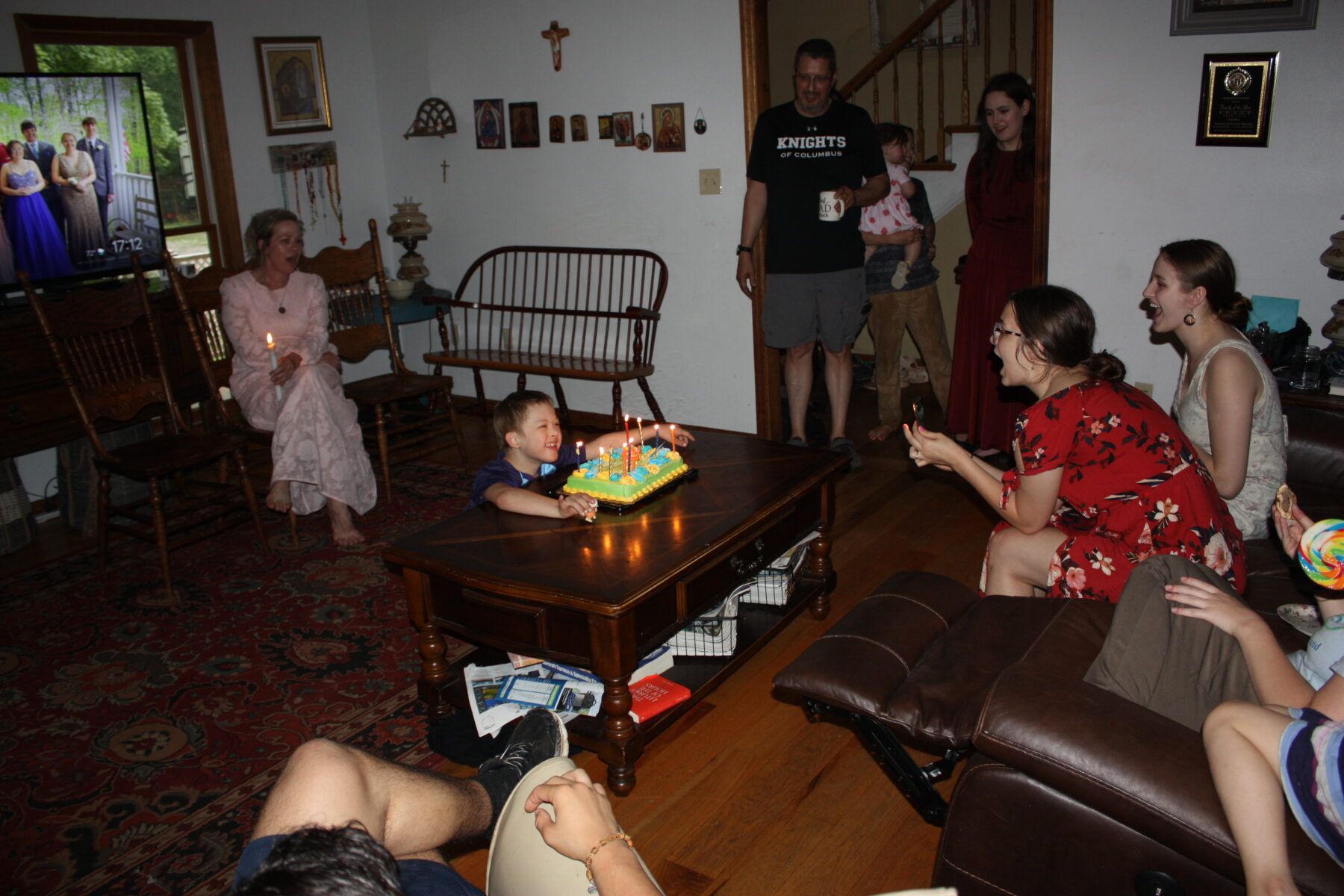
Suffice to say, the Schachles were well steeped in—and sustained by—McGivney’s legacy when they turned to him in their 2015 crisis. “It felt completely natural, because I had been asking Father McGivney for his help already,” Dan told me. Mikey is now homeschooled at what the family dubbed the “Father McGivney Academy.” Michelle said he has some trouble reading when his eyes grow tired. (After the life-threatening condition, fetal hydrops, went away, Mikey still needed surgeries to handle complications from Down syndrome.) On the mantelpiece in the Schachles’ living room sit a framed McGivney prayer card and an encased speck of one of McGivney’s ribs.
During the birthday festivities, Mikey sat on the ground in front of the coffee table, one arm on each side of a cake frosted bright green, yellow, and blue. The attendees filled the dark room, as candles illuminated Mikey’s face and his “Bluey” shirt—one of many gifts he received that Saturday afternoon. (I gave Mikey a stuffed panda and ate two of Dan’s burgers.) Everyone sang “Happy birthday,” and then: “May the good Lord bless you, may the good Lord bless you. May the good Lord bless Mikey, happy birthday to you.”
A subset of the Schachle clan arrived the next morning just in time for the 11 a.m. Pentecost Mass at St. Christopher Church, the only Catholic church in the 490 square miles of Bible-Belt Dickson County. Mikey spent much of the service, which was dedicated to him for his birthday, facing backward in his pew. The elderly deacon, delivering his homily, recounted the story of Pentecost before launching into a series of questions. “Do you want to know the truth? Do you want to know what Jesus taught?”
And: “Do you want to be sanctified, to become a saint?”
III. THE MAELSTROM
Colloquially, a saint is a very good person—kind, selfless, moral. To Catholics, a saint is someone close to God, a dead person to whom the living can turn for an exemplar of holiness and an ally in heaven. One may aspire to follow them, but formal canonization is the end of a bureaucratic odyssey that no person can bring about for him or herself. Anyway, it would be inadvisable to try. “There’s a paradoxical twist there,” said Carlos Eire, a Yale professor of history and religious studies. “You’re supposed to be humble. You’re not supposed to attract attention to yourself.”
For centuries, church law has required two basic elements for canonization: proof that the candidate demonstrated “heroic virtue” in life, making them qualified for veneration, and proof that they have since interceded to work miracles, usually two medical cures. An authentic healing miracle must pass two tests: Is it inexplicable by medical science? And can it be attributed precisely to the intercessor in question? If yes to both, then the Vatican’s Dicastery (formerly Congregation) for the Causes of Saints deems the event a signal of God’s approval for the canonization effort.
The number of canonized saints is all but impossible to tabulate, but the number tied to the United States—as missionaries here, or later as citizens—can be counted on two hands. The Archdiocese of Hartford officially opened the cause for McGivney’s canonization in 1997, fifteen years after the Knights’ centennial commemorations spotlighted their founder’s impact. A thousand-plus-page dossier, commissioned by the Knights to show McGivney’s heroic virtue, prompted Pope Benedict XVI in 2008 to declare McGivney “venerable.”
The Knights printed and distributed prayer cards. They had sought out the presidential historian Douglas Brinkley to undertake a McGivney biography—the book, co-written with the author Julie Fenster, that later inspired Dan Schachle. On the website of the Father Michael J. McGivney Guild for devotees, anyone can add to an ever-growing list of favors credited to him, from vanished tumors to newfound fertility. Each step of the process requires considerable legwork and expertise—including from specialized advocates in Rome—and therefore considerable funding. The Knights have not published a number, but Father Gabriel O’Donnell, who first helmed McGivney’s cause, said the direct costs have surely reached seven figures.
After word of Mikey’s birth ascended the chain of command, the task of investigating the case fell to a tribunal assembled by the Diocese of Nashville, with the medical expert Dr. Fred Callahan. In his slow Southern inflection, Callahan calls himself a “country neurologist,” although his solo practice occupies a small strip mall suite in Nashville proper. He was recruited by the bishop of Nashville, a patient and friend, to collect and summarize the medical data for officials and doctors in Rome. “I turned him down a couple times, but he kept on calling,” Callahan recalled, sitting across from me in his waiting room. “Why do you need a country neurologist for that? It’s neonatal medicine.”
Callahan, now 75, remembers only fragments of the investigation. One step that stuck: “They had guys come from Rome to swear us to secrecy.” He remembers as well the initial feedback on his draft report: “They told me that my conclusion suggested too much that I had an opinion. I said, ‘Well, I’m an American, I’m entitled to have an opinion.’” Upon my asking, he declined to tell me his opinion.
Church officials also had to check that the Schachles had prayed to McGivney and only McGivney. A family friend of theirs who was a seminarian in Rome had prayed with the Schachles during their 2015 trip; he got a call from an investigator inquiring about the targets of their prayers. Jesus and Mary, it turned out, were permissible exceptions.
On May 27, 2020, Pope Francis certified the miracle, allowing for McGivney to be beatified, or declared “blessed.” News articles and videos about Mikey’s previously private story proliferated online, in Catholic and secular outlets alike. In August, the Knights released a video that opens with Mikey, in overalls, on a chair at home. In a voiceover, Dan says, “God writes the best stories, and we didn’t realize what he was doing in our lives.”
God’s story quickly became the Knights’ story. The communications staff in Connecticut kicked into full gear to spread it, installing McGivney and the canonization campaign as central features of the organization’s public image. Victoria Verderame, then a Knights corporate communications manager, told me the shift meant “making a concerted effort to vocalize that Father McGivney is—he is the mission of the Knights of Columbus.”
The celebrations climaxed in October 2020 at the Mass marking McGivney’s beatification. The Schachles stopped in Gettysburg, Pennsylvania, on their drive up to Connecticut, where they were quarantined for four days in the Omni New Haven Hotel. The main service occurred on Halloween at Hartford’s Cathedral of Saint Joseph, with limited attendance. Dan and a veiled Michelle, carrying Mikey, were interviewed live from the church plaza by a studio anchor on the Eternal Word Television Network.
The week before I left for Tennessee, Dan told me his family would not be available to see me. Only once a Knights flack arranged our encounter did I first meet six Schachles at a Cracker Barrel just off the highway. The restaurant was packed and loud at 8 a.m. as we sat down at a round table in the corner. Michelle brought an album of images and timelines reconstructing Mikey’s medical drama. Besides repeated interviews, the Schachles are sometimes treated as small-time celebrities at a friend’s wedding or an out-of-town Mass. “It’s a nuisance, honestly, but it’s a cross that we’re willing to bear to help Christ give other people hope,” Dan said.
His discomfort with all the attention, and with my visit, ran deeper than the inconvenience. “My biggest struggle has been making sure that I am not leveraging the sacred, God’s actions, for my financial personal gain,” Dan said. “I don’t want the publicity. I want to go about doing my vocation of taking care of widows and orphans, and not say, ‘Buy insurance from me because God did this, and I’m great, and all that.’ I don’t want to go to hell because of this.”
In August 2022, the Knights’ 140th Supreme Convention—the first in-person one since the pandemic began, complete with exultation at the Supreme Court’s recent overruling of Roe v. Wade—took place in Nashville. “HOME OF MIKEY’S MIRACLE,” read a Warholesque poster. Supreme Knight Patrick Kelly saluted the Schachles in his main speech, as footage of Mikey at home played on big screens for the convention hall. Dan held up 7-year-old Mikey. “Thank you for saying ‘yes’ to life,” Kelly proclaimed.
At the Cracker Barrel, Dan explained his caution with a parable about a prideful donkey. “They hang the sacred images across the donkey’s back for the parade through town,” he said. “As the donkey comes by, everyone’s kneeling down and praising the images and stuff. And the donkey becomes too proud and won’t go into stable. He’s too good of a donkey, because everyone worships him, right? So, first of all, I’m just a jackass. Whatever’s happened to me is God, not me.”
IV. THE MOTHER CHURCH
As the whirlpool of McGivney’s advance toward sainthood revolved around the Schachles, it would also engulf a New Haven landmark: the church where McGivney spent his seven years in the city. St. Mary’s Church stands on leafy Hillhouse Avenue, surrounded by Yale buildings. Pass by the statue of McGivney to ascend the church steps, and, as one Catholic on campus put it, “you’re entering into a different world.” The floor is wood-tiled, the ceiling mostly sky-blue. Maroon columns rise like clumped-up red licorice.
The building was consecrated in 1874. When 25-year-old Michael McGivney arrived three years later, the church was gravely in debt. Eight years after that, the bishop handed the church to Dominican friars, members of a centuries-old religious order known for an intellectual style that meshed naturally with the Yale milieu. The Dominicans averted financial ruin at St. Mary’s and, beginning in 1907, used a grand house erected next door as their priory, a communal home.
More recently, the Knights of Columbus has picked up the tab on upgrades at the church. For its 1982 centennial, the organization installed a granite sarcophagus for McGivney’s corpse, which was exhumed from a Waterbury graveyard. “The Dominicans came in and saved this church,” Martin O’Connor, a New Haven deacon and St. Mary’s stalwart, said; the Knights, for their part, “have provided extravagantly for the church.” The two groups made for an unlikely symbiosis—between the old and the newer, the cerebral and the corporate. All the while, the Dominicans retained the St. Mary’s pulpit.
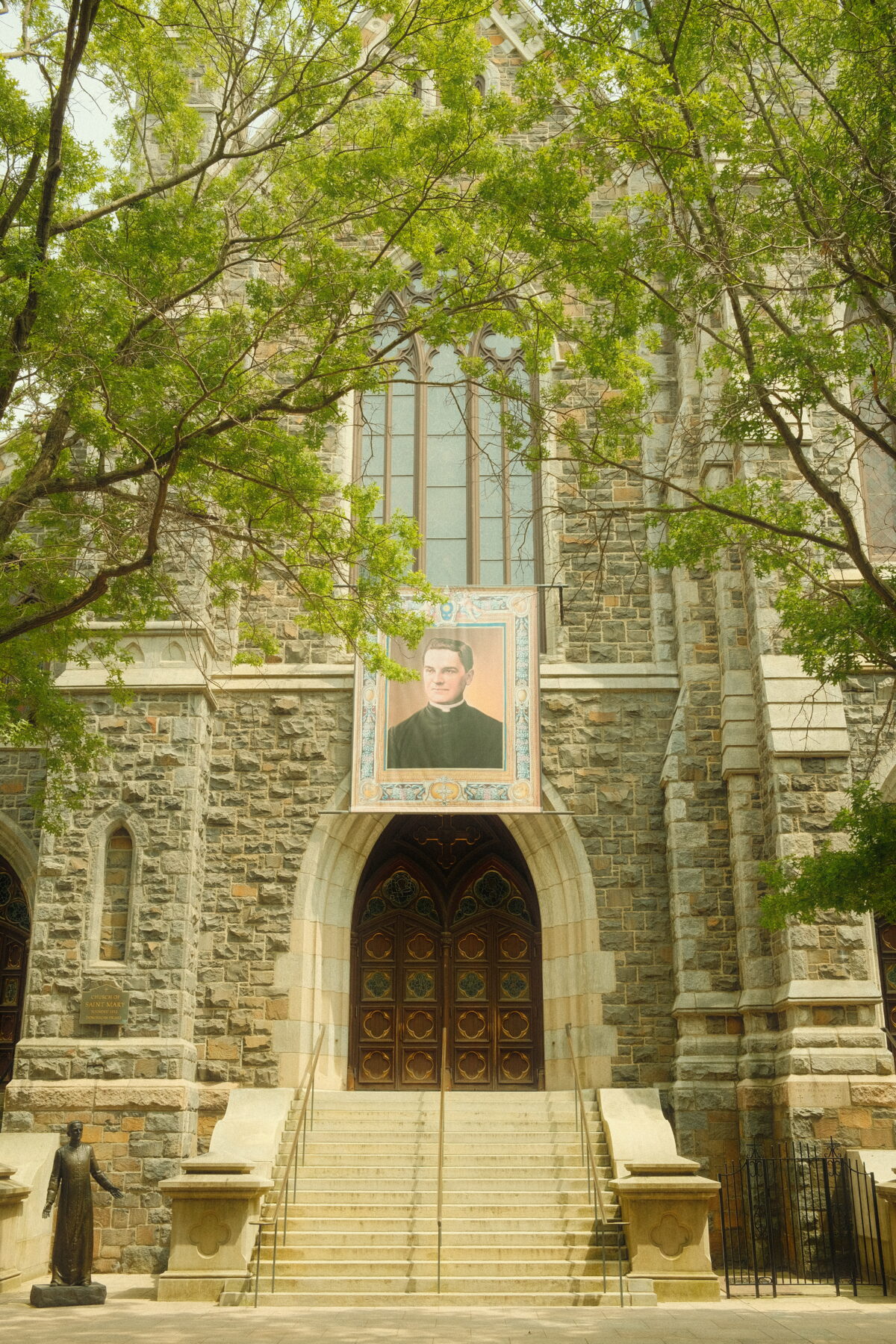
That is, until an ecclesiastical earthquake hit in October 2021: The archbishop of Hartford announced that New Haven’s eight Catholic churches—including a Hispanic one, a Polish-speaking one, and a historically Black one—would merge to form one parish with shared clergy. The official rationale was unremarkable, especially in pandemic-era New England: fewer priests spread thin across abundant churches that had seen fuller days. But the move had an abrupt byproduct. St. Mary’s, “due to its significance, its location,” would be “the mother church” in the hands of diocesan priests, said Father Ryan Lerner, who oversees the consolidated parish. After 135 years there, the Dominicans, it became clear, would have to go.
A Facebook post by the friars announcing their departure accumulated comments from devastated churchgoers: “Heartbreaking news. Blessed Michael McGivney pray for us.” “Executive decisions with hazy rationales are not only upsetting, they are also insulting.” One reaction came from farther afield. “So sorry to hear! [Heart emoji] To our St Mary’s family. Blessed McGivney, pray for St. Mary’s,” wrote Dan Schachle. The episode remains a sore subject at St. Mary’s, where regulars speak in adoring terms about how the Dominicans shaped their spirituality.
Adding to the unsavory flavor of what one parishioner likened to a “dirty real estate play” by the archdiocese, many suspect that McGivney’s beatification less than a year earlier—and his tomb’s heightened power to attract pilgrims—had piqued the archbishop’s interest in taking more direct control of the church. The signs of an ulterior motive stuck out to Eire. “This is so ancient. The bishops like to have the relics. They like to have a church that attracts pilgrims,” he said, adding that, among others who know church history, “we all laughed about it when it happened, and cried at the same time, because it’s just so typical.”
The archbishop, Leonard Blair, who stepped down in May, acknowledged that McGivney’s sarcophagus figured in his decision to remove the Dominicans from St. Mary’s. The archdiocese offered the Dominicans alternative posts, which the friars said they did not have enough time to consider before being kicked out. “We have to have a pastoral plan for the city that also includes the reality of, I hope, a future saint being buried right in the middle of it,” Blair told me over the phone. “And so this was not aimed at the Dominicans or anything. It’s just part of a larger thing.”
It will be a future the Dominicans helped usher in. They tended to McGivney’s tomb and have long held top religious positions at the Knights. One Dominican, O’Donnell, led the canonization effort’s initial phase while living in the St. Mary’s priory and still leads the McGivney Guild. “It’s easy to take a cynical view of it, but I would resist that,” O’Donnell, now 81, said of his fellow friars’ expulsion. Father John Paul Walker, the last Dominican pastor of St. Mary’s, played a key part in honoring McGivney’s beatification the year before. “I guess you could say that there is some irony in the timing,” he allowed.
The St. Mary’s priory, as it’s still imprecisely known in the Dominicans’ absence, now houses the parish offices and several priests. The Dominicans’ exit was “not a good chapter in the history of this parish,” Deacon O’Connor, a former chief of the New Haven Fire Department, said as we sat in the building’s wood-paneled dining room. “The Dominicans changed my life,” he said. “Why would they leave, or be asked to leave, when you have a shortage of priests? So that still baffles me. They built this house.”
Clergymen, anticipating that a Saint McGivney will attract untold pilgrims, said the house may someday be converted into a visitor center with bathrooms and a gift shop.
V. McGIVNEY CITY
As he looks out over Hillhouse Avenue, McGivney’s expression is hard to read. His lips seem to form a frown, yet his boyish cheeks crease around his nose and mouth as if on the cusp of a smile. His shimmery eyes, gazing to the right, suggest something like a distant pride. The official portrait—the chief visual embodiment of McGivney’s afterlife—hangs from the church’s gothic stone facade.
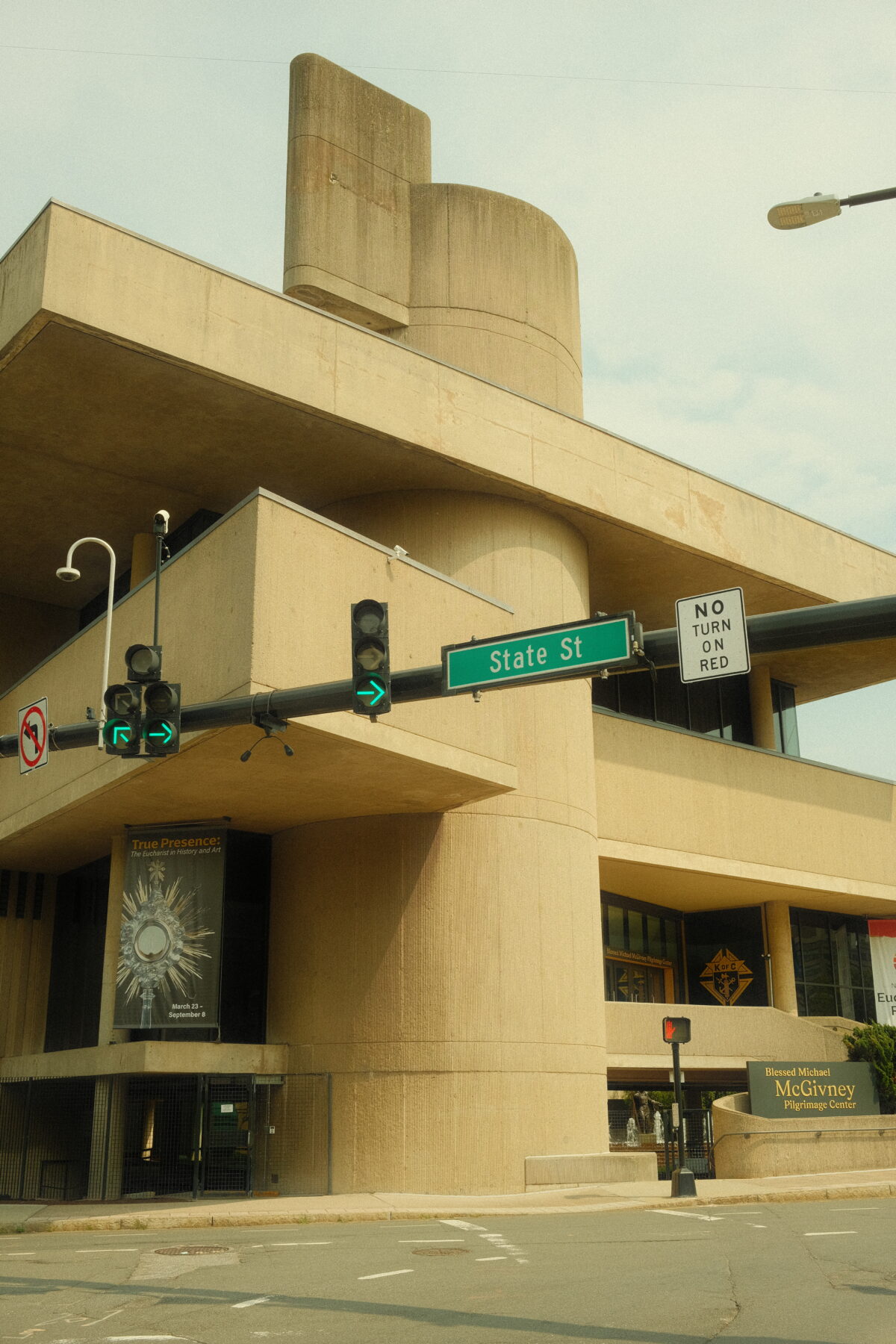
If St. Mary’s Church elevates the man’s face, the global headquarters of the Knights of Columbus—on the other, grayer side of downtown New Haven—further elevates his name. It’s the second-tallest building in town, a modern monument of concrete, brick, and glass with imposing cylindrical towers at its four corners. Emblazoned across three floors’ windows are the words “BLESSED MICHAEL McGIVNEY.”
A brutalist building down the block from the Knights’ tower, once home to a mix of local agencies and organizations, now houses the Blessed Michael McGivney Pilgrimage Center. In July 2023, the city’s consolidated parish was christened the Blessed Michael McGivney Parish. Every Sunday Mass in New Haven includes a prayer for McGivney’s canonization. In short, McGivney has never been more visible in his adopted hometown. “From a Catholic perspective,” O’Donnell wrote in a McGivney Guild newsletter last year, “New Haven, Conn., is now officially ‘McGivney City.’”
A few American-born men besides McGivney are blessed, too. Among them is Stanley Rother, an Oklahoman priest who was martyred during Guatemala’s civil war. It is difficult to know whose proponents will attain their final certified miracle first. According to McGivney’s great-grandnephew, a Bridgeport lawyer, the Vatican has received evidence about a Connecticut woman who recovered from a medical emergency with McGivney’s aid. (The Knights did not respond to a request for corroboration or more details.)
Depending on whom you ask, McGivney stands for the priesthood (his example redeems a vocation plagued by scandal), for baseball (he loved to play), for civic associations (the Knights has defied their decline), for nuclear families (he supported them through tough times), or for American Catholicism’s vitality (his homegrown holiness could be its sign and seed). As the Knights’ avatar, he represents, above all, traditional Catholic manhood, fatherhood, and brotherhood, at a time when the Knights see all three under threat. “If more people knew about the virtue and the aims of Father McGivney, that could change our whole culture,” Dan Schachle said.
Two years after founding the Knights at St. Mary’s, McGivney was transferred from the church to one in Thomaston, Connecticut. He died six years after that, at age 38. If he is canonized, the Knights will no doubt savor a spectacle in Rome. Meanwhile, in Dickson’s tight-knit Catholic community, the Schachle miracle’s certification garnered little attention in 2020, when parishioners were preoccupied with frustration about COVID-19 restrictions. In May, St. Christopher’s priest told me the miracle was “old news.”
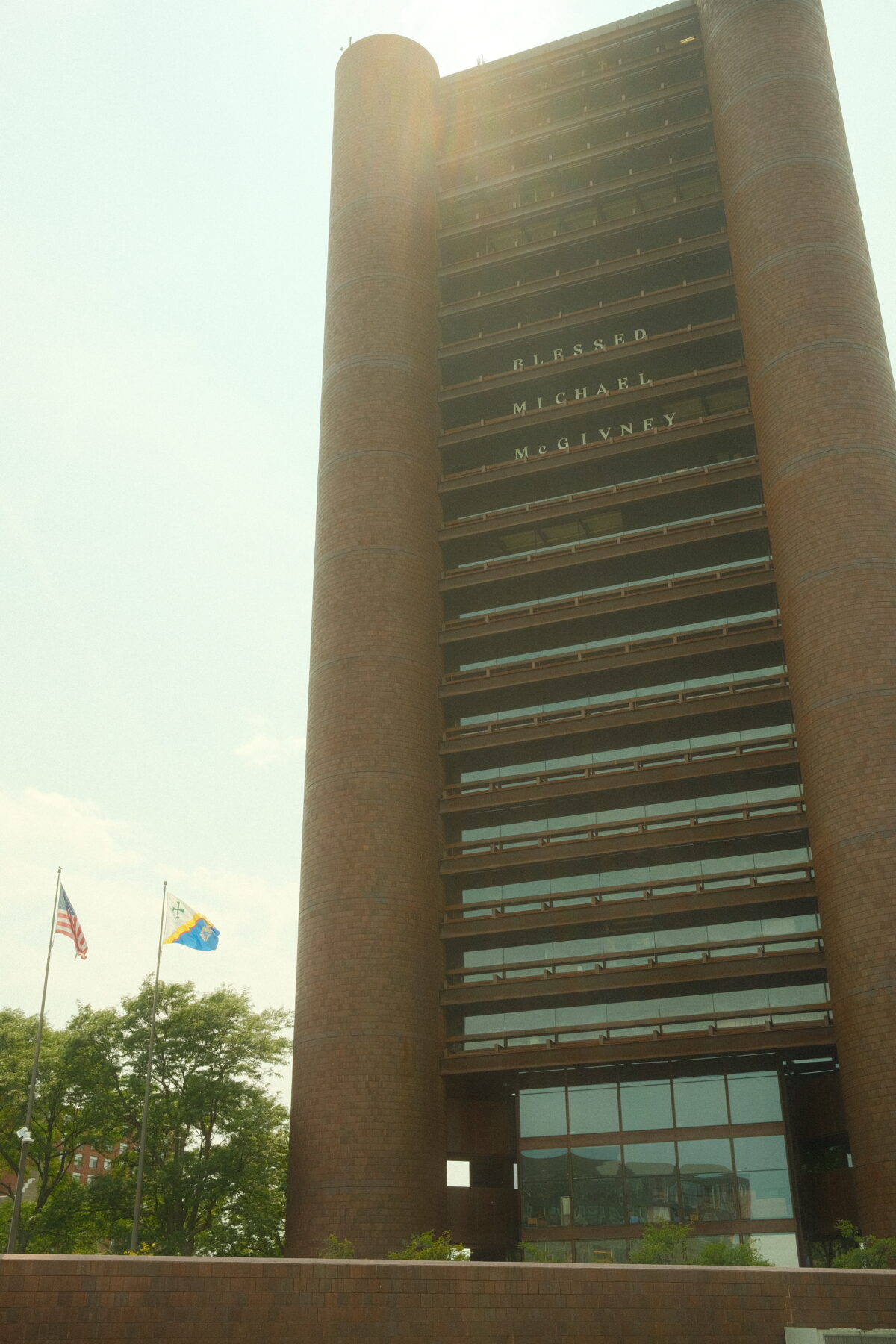
Not so for the Knights of Columbus: A July 2023 promotional video titled “We are the Knights of Columbus” features Dan discussing “Father McGivney’s mission” while a clip of Mikey with two of his siblings rolls. And not so for New Haven, either. The annual feast day dedicated to McGivney comes on August 13, between his birthday of August 12 and his death date of August 14. This year, it featured a special Holy Hour and Mass at St. Mary’s. For almost the first time since McGivney’s stint there, regular diocesan priests are pastoring at St. Mary’s, hoping their forerunner’s rise will invigorate church life. One of the priests has brushed-back brown hair and a youthful face that make him unmistakably resemble McGivney.
During a Sunday Mass in April, in the back left corner of the church, one woman sojourned at length by McGivney’s sarcophagus. Branford resident Victoria Pallotto started frequenting St. Mary’s shortly before the pandemic, drawn in by the Dominicans. Although their departure rankled her, Pallotto has no trouble juggling devotion and disapproval. “We’re all humans. We all have faults and weaknesses and greeds,” said Pallotto, who previously consulted as a headhunter for the Knights.
McGivney has become more than a human: a myth, and perhaps many things more. To Pallotto, he is part of a heavenly world that coexists with ours. The wrinkle where the two worlds meet—where divinity becomes tangible—is a matter of Catholic doctrine: the unity of body and soul. Maybe McGivney’s presence can help others, like Pallotto, bridge the gap.
Long after he died, his inheritors have invested themselves in him, time and again. From Tennessee to Connecticut, and far beyond, they have made his vision their own, putting faith in a future he promises from above. Their investments are multiplying, past living memory of the principal. The greatest reward has yet to come. Call it spiritual insurance. The premiums have been paid.
This project was supported by a Howard Topol Travel Fellowship from Silliman College and by The New Journal’s Edward B. Bennett III Memorial Fellowship.
– Ethan Wolin is a sophomore in Silliman College.


